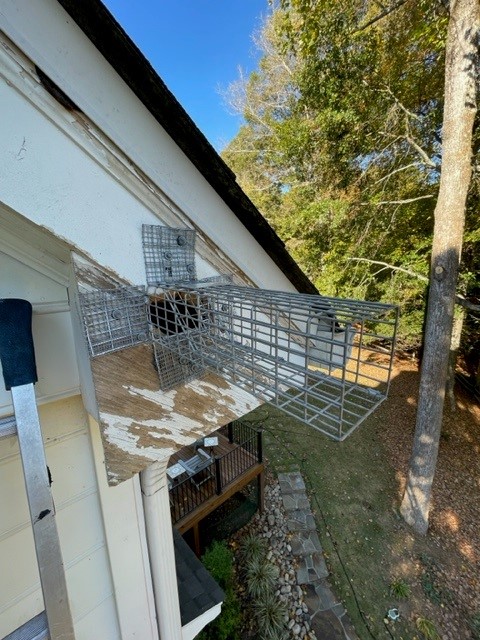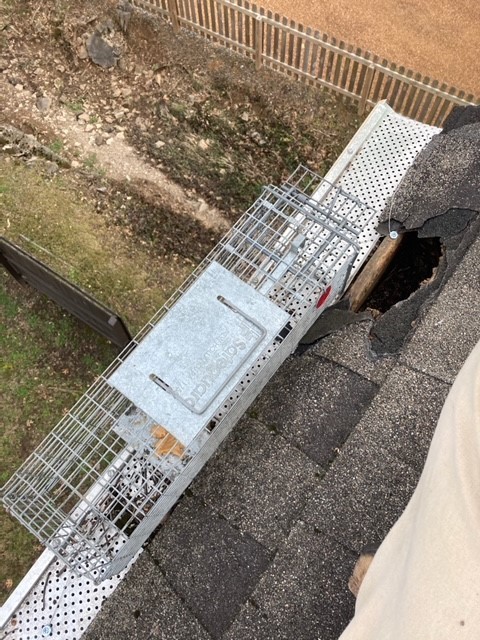Squirrels are commonly found in the area in attics, crawlspaces, walls and eaves around the home. They are most active in the spring and fall when they search for shelter and food. Using a squirrel trap is the safest and most effective way to get rid of squirrels.
Removing squirrels is tricky since they run, climb, and jump very quickly. While technically allowed to catch squirrels with nets or catch poles, it is nearly impossible.
Squirrel Traps
The best squirrel trap is to use a 5- x 5- x 18-inch (minimum) cage or box traps. Box traps are built with solid walls usually of wood, plastic, or sheet metal. Cage traps are made of wire mesh. For squirrels, use a cage trap from ½- x 1-inch mesh. Both live traps can in either one door or two door traps. Snap traps or mouse traps glue traps will not work on most squirrels.
Where to Place a Squirrel Trap
The best place to set these traps are near the entrances to your home or near evidence of squirrel activity. Signs of squirrels include dropping, runs or tracks in the insulation, gnaw marks, and squirrel nests. Do not rely on bait to overcome poor trap placement.
At Critter Control, we usually set more than one trap. For larger squirrels, we set two or three traps. For smaller, squirrels as many as five or more might be necessary.
If young aren’t present, you can get squirrels to evict themselves. Installing a one-way door over the entry point allows the squirrel to leave but prevents their return.
A squirrel excluder can be improvised by mounting an 18-inch section of 4-inch plastic pipe over an opening. The pipe should point down at a 45° angle. Squirrels can gnaw through most house materials. An apron installed around the excluder prevents squirrels from avoiding the trap by creating a new entry point.
Need Help with Squirrel Trapping for Your Home?
Find a Critter Control near you.
The Best Squirrel Trap
At Critter Control, we typically use a cage trap in conjunction with an excluder. It is a one-way door that allows the squirrel to exit but prevents the return. In these circumstances, we check the trap regularly to safely release the squirrel.
What is the Best Squirrel Bait?
The best bait is bait squirrels can’t steal. Squirrel diets consist of wild tree fruits and nuts. Use bait that resembles their diet.
- Peanut butter is one of the best squirrel baits
- Fruit like slices of oranges and apples
- Shelled nuts like walnuts and pecans
- Foods squirrel familiar with like corn and sunflowers
Where to Place Squirrel Trap
Place your trap on a flat surface along your squirrel’s travel path. You can identify a squirrel’s travel path from the runs in the insulation.
Squirrel trapping is the safest option, but it requires skill. You need to identify potential entry points, place traps strategically, and check them often so as to not harm the squirrel. If you don’t repair all squirrel entry points, your house is still vulnerable to squirrel infestations.
Critter Control squirrel trapping specialists will trap and relocate squirrels.
Squirrel Exclusion
Squirrel trapping solves the immediate squirrel infestation. Your home has already been shown to provide ample resources for squirrels. Without exclusion, you are still at risk for future squirrel infestations.
Seal entry points with sheet metal or hardware cloth.
Home exclusion is the most effective method to prevent squirrels or nuisance wildlife from entering your home. It is essential to seal all current and potential entry points with sheet metal or hardware cloth to prevent future squirrel infestations. In addition, we strongly recommend a maintenance service. Like other rodents, squirrels have front teeth that continuously grow, which means they can gnaw a new way back into your home.
How to Identify a Squirrel Problem
It’s easy to identify a squirrel when you see the bushy tail, small paws, short legs and long fur, but it can be harder to determine squirrel species.
Tree squirrels and flying squirrels are much more likely to nest in your attic. Tree squirrels include eastern gray squirrels, fox squirrels, red squirrels, tassel-eared squirrels and western gray squirrels. There are two species of flying squirrels— the Northern Flying Squirrel and Southern Flying Squirrel.
In certain parts of the country ground squirrels are an issue. Ground squirrels include Belding squirrels, California squirrels, Rock squirrels, Richardson squirrels, Townsend squirrels, Washington squirrels and Columbian squirrels.
Most squirrels will flee if you walk towards them and you may see one in the area scurry up a tree. If you hear scurrying and scratching noises in your walls or ceiling, notice damage or holes on the exterior of the house or smell urine, you may have a squirrel problem. Squirrels are most active in the morning, so pay attention to when you hear the noises.
If you suspect a squirrel problem, contact the squirrel trapping specialists at Critter Control for squirrel trapping services.
Where to Find Squirrels
Squirrels are commonly found in the area in attics, crawlspaces, walls and eaves around the home. They are most active in the spring and fall when they search for shelter and food. A squirrel’s diet mostly consists of nuts, roots, tree bark, leaves, acorns and small insects. When you notice a squirrel problem it’s important to quickly contact a squirrel expert in the area that is trained in squirrel trapping. Squirrels can run fairly quickly, jump long distances and scale nearly anything, so trying to implement your own methods of squirrel trapping can quickly turn into a huge mess.
How to Identify a Squirrel Problem
It’s easy to identify a squirrel when you see the bushy tail, small paws, short legs and long fur, but it can be harder to determine the type of squirrel. Ground squirrels include Belding squirrels, California squirrels, Rock squirrels, Richardson squirrels, Townsend squirrels, Washington squirrels and Columbian squirrels. Tree squirrels include eastern gray squirrels, fox squirrels, tassel-eared squirrels and western gray squirrels. Most squirrels will flee if you walk towards them and you may see one in the area scurry up a tree. If you hear scurrying and scratching noises in your walls or ceiling, notice damage or holes on the exterior of the house or smell urine, you may have a squirrel problem. Squirrels are most active in the morning, so pay attention to when you hear the noises. If you suspect a squirrel problem, contact the squirrel trapping specialists at Critter Control for squirrel trapping and removal services.
Why Squirrels Are Important
Although squirrels can be a big nuisance and cause a lot of damage very quickly, they are important to nature. Since they naturally dig and bury seeds and nuts, they are a huge contributor to keeping forests dense, helping with reforestation, and aerating the soil as they dig. Other animals find shelter in the tunnels they dig. They also provide natural insect control, especially for beetles and grubs. Squirrels are important ecologically, but they provide no benefits if they are living in your home, so contact Critter Control for squirrel removal services if you have a squirrel problem.
Why You Find Squirrels in the Yard and Squirrels Around the House
Squirrels will build nests in the area wherever they can find shelter, often for their young. They will live in the same location as long as they are not threatened if squirrel trapping is not put in place. Squirrels can dig under sheds and houses to gain access and once they gain access through one entry point, they will continue digging to store food and create other entry points. If you notice squirrels running in and out of your shed, home, attic, or garage, contact Critter Control for squirrel trapping services.
What Damage and Hazards are Caused by Squirrels
Squirrels can cause a great deal of damage if they gain access to your home, garage, or shed. They will destroy attic insulation, chew through the exterior of a home and chew through electrical wiring. A squirrel will build a nest in an attic for litter, which generally happens in the spring and fall and can be very noisy, especially in the morning around sunrise. Squirrels can also carry certain diseases, parasites, and fleas. They generally flee when they feel threatened and they don’t normally bite, but it’s important to stay away and contact an expert trained in squirrel trapping in the area if you notice anything unusual.
Squirrel Removal
Removing squirrels can be very tricky since they run, climb and jump very quickly. Squirrel trapping is the safest option and will require a squirrel trapping expert. Critter Control squirrel trapping specialists will trap and relocate squirrels and may use toxicants or fumigants to force squirrels out of a location.
How to Prevent a Squirrel Problem
Preventing a small squirrel problem from becoming a large squirrel problem requires exclusion and sealing possible entry points. Sealing known access points with metal can deter squirrels from trying to chew or reopen the entry points. Squirrel trapping and squirrel relocation helps to prevent squirrels from gaining access to shelter in your home. Contact the squirrel trapping experts at Critter Control for squirrel trapping services.
We can help you get rid of squirrel problems. Call today: 1.800.274.8837
Learn more about squirrel removal.
Additional Sources:
https://icwdm.org/species/rodents/tree-squirrels/tree-squirrel-damage-prevention-and-control-methods/
https://digitalcommons.unl.edu/icwdmhandbook/10/
Get them out.
Keep them out.®
Experiencing a wildlife or pest issue? We can help! Complete this form and your local Critter Control® office will contact you to assist.
- How to Get Rid of Squirrels
- Squirrels Entering Homes
- Squirrels in Attics
- Squirrels in Chimneys
- Squirrels on Roofs & in Soffits
- Squirrels in Walls
- Squirrels in Ventilation
- Squirrels in Gutters
- Squirrels in Crawl Spaces
- Squirrels in Yards or Gardens
- Squirrels in Trees
- Squirrels Digging Holes in the Ground
- How to Identify Squirrel Sounds
- Squirrel Tracks
- Squirrel Droppings
- Squirrel Repellents & Deterrents
- Squirrel Appearance & Identification
- Species & Types of Squirrels
- Squirrel Life Cycle
- Baby Squirrels
- Squirrel Nest
- Dead Squirrels
- Squirrel Diet
- Diseases That Squirrels Carry
- Rabid Squirrels
- Do Squirrels Hibernate?
- Gray Squirrels
- Do Squirrels Bite?
- Squirrel Damage to Your House
- Squirrels vs. Rats
- Squirrels vs. Chipmunks

